The Art Institute of Chicago'The Modern Wing
Renzo Piano Building Workshop bridges a historic structure and a grand public space with its trademark Classicism at The Art Institute of Chicago's Modern Wing.
Architects & Firms
Originally intended as a small addition on the southern end of the museum’s site, as plans for Millennium Park firmed up, the building’s location shifted to Monroe Street, across from the new civic center and directly facing the Pritzker Pavilion, Frank Gehry’s billowing outdoor concert venue. “Having seen the Menil Collection and his other museums, we knew Piano could make great spaces for art,” recalls James Wood, the Art Institute’s former director. “But he also had a record as a planner beyond individual buildings. The Modern Wing needs to bind the Art Institute to the heart of the city.”
Along with the move came a much grander building scope, more than tripling in size, to 264,000 square feet of pristine galleries and a sprawling education center, housed within a series of boxy, glazed volumes beneath Piano’s familiar, natural-light-diffusing canopy, or “flying carpet.” Opposite the sculpture terrace and upscale, rooftop restaurant (amusingly called Terzo Piano, a nod to the architect and Italian for third floor), the Nichols Bridgeway—the first large-scale footbridge designed by Renzo Piano Building Workshop (RPBW)—reinforces the visual connection to Millennium Park with a physical access.
RPBW also creates a strong connection to the historic buildings—the original structure designed by the Boston firm Shepley, Rutan and Coolidge for the 1893 World’s Columbian Exposition, and later additions—pulling off a seamless interior transition between old and new despite vast differences in material and scale. On the exterior, the new wing’s Classicized Modernism pays homage to the Beaux-Arts building without upstaging it.
Museumgoers who enjoy losing themselves in the art, and in the museum itself, are best advised to visit the older buildings, whose galleries were completely reorganized and thoughtfully renovated with the expansion. Piano’s highly rational, modular galleries are too compartmentalized to allow for that sort of aimless wandering. But the new building does take cues from its predecessors. The atriumlike Griffin Court matches, in spirit at least, the Grand Staircase that welcomes visitors at the Michigan Avenue entrance. It far surpasses it, though, in breadth. Running the length of the new building, the soaring, double-height, skylit volume serves as the main artery of the Modern Wing, providing access to first-floor galleries, visitor services, the museum store, and the 20,000-square-foot education center, which replaces a basement one half its size. A suspended staircase—whose all-glass railings make it appear to float within the immense space—seems to be the preferred means of access to the second- and third-floor galleries, though the ride in the glass-enclosed elevator offers views over the Pritzker Garden, an outdoor seating area.
Despite the heavy traffic through these spaces in the weeks following the opening, the Modern Wing achieves an unexpected serenity, due in part to its acoustical strengths, but more than that, to an overall design that seems effortless in its simplicity. Circulation, on the other hand, is not always as effortless. Those arriving via the footbridge descend three flights by escalator to enter the museum through the tight coat-check area. From the opposite end, with no direct access between the third-floor galleries and the sculpture terrace and restaurant, visitors are forced to travel back down through Griffin Court and up a single elevator, which, given early crowds, can lead to a wait.
Most visitors, however, are in no hurry to leave those third-floor galleries, the highlight of the new building. It is here that the flying carpet works its magic. Beneath this canopy of aluminum blades designed to capture north light, the Brancusis, Picassos, and Giacomettis on display glow within a luminous box. The veiled translucency—a scrim hovers beneath the glass ceiling—imbues these spaces with a celestial aura, even on overcast days or during a downfall, though according to Piano, “the sun gives it life.”
Piano has incorporated light-filtering canopies in many of his museums, including such small art galleries as the one atop his Lingotto Factory Conversion in Turin, Italy, its flying carpet perhaps most similar to the one at the Modern Wing. “The advantage in Chicago is that the city was laid out according to the cardinal directions; north is true north,” Piano says. He also admits that other changes in the design of these canopies evolved due to increased attention to sustainability. “That was not as much of a focus years ago, and some of the earlier galleries experience heat gain.” Though the Modern Wing is seeking LEED Silver certification, it has drawn criticism for not being green enough, especially for an architect, and a city, known for their sustainable practices. Visitors have expressed their aversion to the vertical shades, which the museum has so far kept drawn over the glass walls until evening hours.
Where the Modern Wing succeeds most, like Millennium Park across the street, is as a civic space. At $300 million, it may, sadly, be the last of its kind for a while. And as different as the Modern Wing is from Piano’s first museum—Paris’s revolutionary Pompidou Center, designed with Richard Rogers—it plays a similar role as a magnet for the masses. Even the Nichols Bridgeway, which when seen from afar may appear as an awkward appendage or an afterthought, has its merits. Generously scaled, the experience of walking over it is a thrilling one in Chicago, with incredible views of Lake Michigan and the city’s famous skyline. Its muscular profile, together with the templelike building, is a fitting addition to that skyline, responding to Chicago’s rich architectural heritage, and setting the stage for its future.




